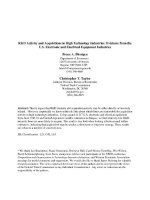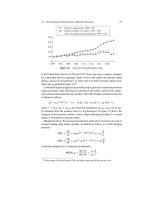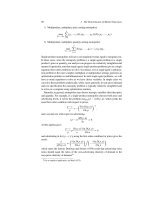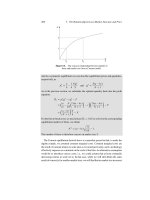Winners losers microsoft competition and antitrust in high technology
Bạn đang xem bản rút gọn của tài liệu. Xem và tải ngay bản đầy đủ của tài liệu tại đây (11.7 MB, 347 trang )
Winners,
Losers &
Microsoft
Competition and Antitrust
in High Technology
Revised Edition
Stan J. Liebowitz
Stephen E. Margolis
Foreword by Jack Hirshleifer
Oakland, California
Copyright ©1999, 2001 by The Independent Institute
The Independent Institute
100 Swan Way, Oakland, CA 94621-1428
Telephone: 510-632-1366 • Fax 510-568-6040
E-mail:
Website: http//www.independent.org
All rights reserved. No part of this book may be reproduced or
transmitted in any form by electronic or mechanical means now
known or to be invented, including photocopying, recording, or
information storage and retrieval systems, without permission in
writing from the publisher, except by a reviewer who may quote brief
passages in a review.
Library of Congress Catalog Number: 99-73414
ISBN: 0-945999-80-1
Published by The Independent Institute, a nonprofit, nonpartisan,
scholarly research and educational organization that sponsors
comprehensive studies on the political economy of critical social and
economic issues. Nothing herein should be construed as necessarily
reflecting the views of the Institute or as an attempt to aid or hinder
the passage of any bill before Congress.
Table of Contents
Foreword by Jack Hirshleifer
Preface to the Revised Edition
Acknowledgments
I
The Paradigm
1. Networked World
2. The Fable of the Keys
II
The Theory
3. Theories of Path Dependence
III
iv
viii
x
1
2
19
45
46
4. Network Markets: Pitfalls and Fixes
65
5. Networks and Standards
85
The Real World
114
6. Beta, Macintosh, and Other Fabulous Tales
115
7. Using Software Markets to Test These Theories
133
8. Major Markets—Spreadsheets and Word Processors 161
9. Other Software Markets
200
10. The Moral
234
Appendices
A. Networks, Antitrust Economics, and the Case
Against Microsoft
245
B. The Trial
275
Bibliography
Index
About the Authors
313
315
326
Foreword
History matters. This is an unexceptionable assertion, surely, but one that has also become a slogan in the current economic literature, intended to epitomize a newly discovered flaw in the market
system. The flaw is this: the merest of historical accidents, perhaps an
early engineering choice by a technology pioneer responding to some
random influence or ephemeral advantage, locks in future generations
to an inefficient technology owing to path dependence. Examples of
such supposed market failures include the notorious QWERTY keyboard that has bedeviled typists for nearly a century, failure of the
Beta videotape format to replace the inferior VHS design, and the
strangely persistent quirky English inches, ounces, and quarts in the
face of the more rational metric system of measures.
Analytically, path dependence is blamed on network effects. An
initial mistaken (or only temporarily correct) choice retains a kind
of natural monopoly over a superior one. Electric autos might be
better than gasoline-driven ones. But given that there are almost no
recharging stations, a private individual does not find it sensible to
buy an electric car. Nor can any firm profitably install recharging
stations when there are so few electric cars around to use them. Everyone is supposedly aware of the inefficiency, yet no single rational
decision-maker—having to conform to the actions of everyone else—
is in a position to correct it.
Stan Liebowitz and Stephen Margolis show that inefficient outcomes due to network effects are indeed theoretically possible in
a market economy, though only under rather stringent conditions.
These outcomes are a matter for empirical study. How frequently
do such inefficient lock-ins actually happen? Liebowitz and Margolis’s fascinating historical review of the leading reported instances
demonstrates that several of them, notably the QWERTY problem,
are essentially mythical while other widely accepted stories represent misinterpretations of the evidence.
iv
Foreword | v
To begin with, path dependence is inefficient only when an inferior product survives at the expense of a superior one and if the costs
of changing over do not exceed the value of the postulated quality
improvement. Omitting this rather obvious qualification represents
what Harold Demsetz has called the Nirvana fallacy: comparing a
real-world actuality with a hypothetical ideal not within the range
of feasible opportunities.
Network effects constitute a possible source of natural monopoly
and lock-in that operates on the demand side. (In contrast with the
traditional explanation of natural monopoly as due to decreasing average cost, increasing returns on the supply side.) These demand-side
increasing returns stem from the advantages of synchronization.
The value of a good to a consumer may depend not only on the
characteristics of the commodity itself but also on how many other
users have adopted the same product. This is evidently true of literal
networks such as the telephone system (there is no point having a
phone if there is no one else to call). And to a degree the same logic
applies to any product for which person-to-person compatibility and
standardization are advantageous. Notably, in computer hardware
and software there are efficiency gains to be made if people can
exchange files with one another or move from machine to machine
without worrying about incompatible standards and formats.
Liebowitz and Margolis explore the range and limits of these network effects. Suppose product A is superior to B, in the sense that all
consumers prefer the former at each and every possible given ratio of
market shares. Thus, A would be preferred over B if they each had 10
percent of the market, or if each had 20 percent, and so on. Yet such
a superior product may indeed fail to displace an inferior one if the
incumbent starts with a sufficient initial preponderance. (With 90
percent of the market to begin with, B might be preferred by most
consumers over a superior newcomer A with only 10 percent.) That
is the essence of the market failure due to network effects, and it
can happen.
But Liebowitz and Margolis do not stop at this point. They go on
to ask what rational consumers and rational suppliers, faced with
such a situation, would be expected to do—and whether we actually
observe such responses. Manufacturers of innovative superior products are not powerless; there are ways to enlarge market share. For
a firm aiming to acquire the critical mass needed to tip consumers’
vi | Foreword
decisions in its direction, evident possibilities include offering a low
introductory price or money-back guarantee. And because by hypothesis the new product really is superior, the new entrant might
profitably subsidize the cost of the user’s changeover, and even commit to pay the cost of changing back should that be desired. All of
these devices are observed in real-world markets. Furthermore, just
as suppliers can often find ways to escape the stasis trap, so can buyers. Users can and do remain alert to technological progress; in the
computer field, Liebowitz and Margolis show, published product
reviews in magazines aimed at consumers have had very significant
effect on market share. Given the likelihood of the superior product eventually winning the battle, foresighted purchasers may well
(among other things) demand the same return and exchange privileges from incumbents as from newcomers B thereby attenuating
the market advantage of simply having been first in the field.
In what for many readers will be the most exciting portion of the
book, the authors go on to examine histories of alleged market failures, starting with QWERTY. Were producers and consumers actually locked into inferior market solutions? And if not, what devices
were employed to escape the supposed trap? I will say no more on
this topic here, so as not to take the edge off the authors’ accounts
of the creativity and ingenuity displayed by both suppliers and consumers in the competitive battle for critical mass.
Finally, there are important implications for economic theory
and public policy. High-tech markets, the authors show, do challenge some of the old textbook verities, though in ways somewhat
different from those emphasized in most recent discussions. In a
high-tech world, all market participants must anticipate continuing
product changes. Incumbent suppliers have to decide how often to
put improvements on the market, how big a change to make each
time (among other things, how to balance between optimality and
compatibility), and what to do about prices. And rational consumers
must correspondingly anticipate such supplier decisions, taking into
account the likely entry of market contenders with entirely new
offerings.
Turning from decision-making to overall market effects, one implication is that economists need to reconsider notions of competition. The authors show that, in tech markets, predominant market
share may be the consequence and hallmark of effective competition. This often takes the paradoxical form of serial monopoly, as
Foreword | vii
instanced by WordStar giving way to WordPerfect, which in turn
lost out to Microsoft Word.
As for economic policy, a firm’s having dominant market share
need not lead to exploitation of consumers by high prices or
low-quality products. In support of their argument, what better evidence can there be than the history of rapidly improving products
and falling prices in high-tech industries, even where single firms
have had dominant shares in particular markets? This point has obvious implications for antitrust issues, as elaborated by the authors,
with particular attention to the Microsoft story.
So increasing returns/synchronization effects and consequent tendencies toward market concentration are indeed important in tech
markets. But equally important and more in need of analytic appreciation are the steps that consumers and firms can take to deal with
these effects. Dominant market share attracts competitors anxious to
offer new and improved products to watchful and alert users. The
situation may be one of natural monopoly, but no firm can retain
such a monopoly position unless it matches or surpasses what hungry outsiders are ready and anxious to provide. In an increasingly
high-tech world, competition does not take the textbook form of
many suppliers offering a single fixed product to passive consumers.
Instead it becomes a struggle to win, by entrepreneurial innovation
and sensitivity to consumer needs, the big prize of dominant market
share. It is this form of competition that has been mainly responsible
for the success of the modern American economy in recent decades.
Jack Hirshleifer
Professor of Economics
University of California
Los Angeles
Preface to the Revised Edition
When we were finalizing the proof for the first edition,
the Microsoft trial had just begun, but it was already well on its
way from a narrow examination of certain business practices to a
broad examination of the Microsoft’s role as the provider of the
standard platform for desktop computing. Not long after publication, the court issued its findings of fact. As we prepare revisions
for this second edition, not quite a year later, the appeals process
has not yet begun.
The trial brought a surprising amount of attention to the first
edition, attention that is in part responsible for the paperback edition. We anticipated that chapters 8, 9, and 10 (which deal directly
with some of the reasons for Microsoft’s market position) and the
appendix (which examines antitrust issues) would be of interest
to people who followed the trial. We did not suspect, however,
that the subject of network effects would play a role in the court’s
decision. Although the ideas of lock-in, path dependence, and network effects—ideas that we examine critically throughout the
book—underpinned the government’s claim on economic justification for its activism in high-technology markets, we thought that
the judgment would most likely hang on more-established antitrust doctrines.
But in fact, the trial and the especially the court’s decision did
rest heavily on lock-in explanations of various sorts. The court’s
findings are peppered with phrases such as “the collective action
problem,” “the chicken and egg problem,” and the “applications
barrier to entry.” Such phrases indicate that the appellate process
may have to decide, among other things, whether it is appropriate
to build antitrust doctrines on such unseasoned foundations.
Although the courtroom activity has moved apace, market activity has moved even faster. Technological development has moved
away from the desktop and toward communications channels and
viii
Preface | ix
other data-handling devices. Generation changes—what we refer to
as “paradigm changes” in chapter 7—seem to be upon us in several
areas, most notably in the rise of the Internet as the possible central focus of computer activity, and the movement away from PCs
to personal-information managers, cellular phones, and game
machines. Additionally, AOL, after its purchase of Netscape, has
merged with Time-Warner, removing any David-versus-Goliath
component from the browser wars.
This edition adds another appendix that considers some economic issues the trial raised and a discussion of the court’s remedy.
Otherwise, it is largely unchanged form the first edition, except for
the correction of some typographical and other minor errors.
Acknowledgments
This book would not have been written without the encouragement, even prodding, of David Theroux. As this project developed, David had a continuing influence on its shape and scope.
We thank David and the Independent Institute for his enduring
confidence in this project and for his support of our research efforts.
We owe a deep debt to Jack Hirshleifer who has provided his
encouragement, wisdom and advice over the years. He has been a
mentor, a role model, and tireless advocate of our work. We wish to
publicly thank him for all the times he has circulated our papers or
otherwise injected our arguments into various debates on the workings of social systems. We are thrilled that he agreed to write the
forward.
Various journal editors, referees, and others have helped us in our
writings on these subjects over the years. We extend our gratitude
to Bill Landes, Oliver Williamson, Richard Zerbe, Peter Newman,
Timothy Taylor, Virginia Postrel, Nick Gillespie, Bill Niskanen, and
anonymous referees who have helped us improve our thoughts and
ideas. Nancy Margolis deserves special thanks for applying her expertise as an editor and writer to salvage our prose. Bruce Kobayashi,
George Bittlingmayer, William Shughart and Alex Tabarrok read
the manuscript thoroughly and provided many detailed comments.
We have relied heavily on their work and we thank them for their
efforts.
The software chapters benefited from insights and encouragement from two software veterans, Bob Frankston, co-inventor of
the spreadsheet, and Gene Callahan, who was in charge of various
aspects of “Managing Your Money” before moving on to his own
company.
We thank our colleagues for their encouragement over the years
as we wrote the papers that form the core set of ideas exposited here.
We particularly would like to thank: Craig Newmark, John Lott,
x
Acknowledgements | xi
Ed Erickson, Lee Craig, Chuck Knoeber, David Flath, John Seater
and Joel Mokyr. We also acknowledge contributions from George
Stigler in the early states of this research. We thank our respective
universities for their support, and to the UTD Management School
which provided some financial support.
Chapters 8 and 9 could not have been written without a great deal
of research support. We first thank our two main research assistants,
both students at the time at UTD, Greg Bell (now at IBM) and Chris
McAnally, for doing a fabulous job. Xiaojin Chu, provided clean-up
support. We also need to thank Deborah Robinson, the chief librarian at Microsoft, who provided access to much of the data.
Over the years we have benefited from comments by participants
at seminars presented at: Clemson University, the Fuqua School of
Business, George Mason University, Harvard University, the Kennan Flagler School of Business, New York University, North Carolina State University, Southern Economic Association, Southern
Methodist University, UCLA, University of California at Santa Barbara, Simon Fraser University, University of Georgia, University of
Michigan Business School, and Wake Forest University.
Errors of course are our own. We have, unfortunately, been unable to pursue all of the good suggestions we have received and have
meddled with the text right to the end.
Finally we thank our wives, Nancy and Vera, and families for
enduring occasional absences and frequent crabbiness in the final
stages of this project.
p a r t
o n e
The Paradigm
In laissez-faire economies, resources are allocated by the
independent decision-making of firms and individuals—what we
often call the free market. Beginning with Adam Smith, one of the
central questions of economics has been whether all this independence of consumers and producers leads to anything that we could
judge to be good, or more precisely, whether it leads to the greatest
achievable wealth and efficiency. For Smith, and for much of economics since, the conclusion has been that for the most part it does.
That is not to say, however, that economists never find imperfections in free markets. On the contrary, much energy ahs been spent
answering the policy question: How can we improve upon independent decision making? This quest for improvement, however, has
proven to be difficult. Economists have sometimes spent time and
energy analyzing some purported market imperfection, only to have
it shown decades later that the imperfection doesn’t occur, or that
there is no realistic means of overcoming it.
In Part One we present an overview of the most recent claim of a
market imperfection. The claim is that free markets are not capable
of making good choices among competing products, technologies,
and standards where the values of these things depend upon interactions among users. Instead, markets are alleged to “lock in” to inferior choices.
The paradigm-setting case for this claim of market failure is the
typewriter keyboard. This section presents our treatment of the history of the typewriter keyboard, which was first published in 1990.
As we show, the keyboard story concisely illustrates not a market
failure but rather a market success.
1
Networked World
“Build a better mousetrap and the world will beat a path
to your door.” This adage, most often attributed to Ralph Waldo
Emerson, is implicit in enough economic thinking that it might well
take its place alongside “Incentives matter” and “Marginal returns
eventually decline” as a fundamental building block. In the past decade, however, some journalists, bureaucrats, and even some economists have begun to doubt Emerson’s adage. The markets for new
technologies, they say, seem to behave differently from the markets
for traditional goods and services. Laissez-faire policies may have
produced good results in other times, but they cannot be relied on
in the Age of Technology. Emerson, they say, may have been right
about mousetraps, but his adage doesn’t hold up so well if the only
mouse in sight is a computer mouse.
Doubts, of course, are niggling things, but once they gain a
footing, it’s only human nature to look for evidence that doubts
may be facts. And the evidence seems to be everywhere. Consider the typewriter keyboard. Everybody knows that the QWERTY
keyboard arrangement is completely arbitrary. We’d all be better
off if we had a different one, but changing now would just be too
much trouble. We stick to the old, inefficient arrangement only
out of unhappy habit. The market failed us on that one, didn’t it?
And what about VCR format? Surely you’ve heard that the Beta
format was much, much better than the VHS format that dominates
the market today. Another market failure?
Or let’s look at the war between Apple and DOS operating systems. Talk to any Mac owner. He’ll be quick to tell you that Macintosh was a whole lot better than DOS. We’d all be using the Mac
today except for one thing: The market failed. Didn’t it?
If such stories were true, the evidence would be incontrovertible:
In markets for technology, the best does not always prevail. And in
this unpredictable New World, quality would lose out to the oddest
2
Networked World | 3
things: a trivial head start, an odd circumstance, a sleight of hand.
When there are benefits to compatibility, or conformity, or certain
other kinds of interaction that can be categorized as network effects,
a single product would tend to dominate in the market. Moreover,
this product would enjoy its privileged position whether or not it
was the best available.
Thus, the new technology gives economics, the dismal science,
a chance to forge an unhappy marriage with the bad-news media.
Journalists have been quick to file the bad-news story of how the
world is not only unfair, but also illogical. Private litigants in the
antitrust arena file suits alleging unfair competition. Incumbents,
they say, are using unfair advantages to foist inferior products on an
unsuspecting public. The U.S. Justice Department has been quick to
second the notion, using it to support their cases against Microsoft
and other successful U.S. firms.
The good news for consumers, though the bad news for the
failure-mongers and the U.S. Justice Department (and possibly for
consumers if the Department of Justice should prevail), is that the
economic theory of a high-tech market locked in to failure has its
foundation only in shallow perceptions—not in facts. A hard look
at the claims of real-world market failures shows that they are not
failures at all. The winners in the high-tech world have won not by
chance, but rather by the choices of consumers in an open market. A
responsible examination of the historical record provides evidence
that entrepreneurship and consumer sovereignty work as well in
high-tech markets as they do in more traditional ones—which is to
say, very well indeed.
Does Wheat Separate from Chaff?
The prospect that the mediocre prevail is certainly intuitively intriguing. Anyone who has spent any time watching the celebrity
talk shows, where celebrities talk about being celebrities, has already confronted a version of the world where cream doesn’t seem
to rise to the top. Do television commentators really represent our
best intellects? How many of these people are famous for being
famous? How many of them just look and sound good, inasmuch
as they merely need to read statements over a teleprompter?
4 | Winners, Losers & Microsoft
One might also ask how many political leaders represent the pinnacle of the talent pool. It is easy to suspect that success might be
arbitrary. Alternatively, if success is not perfectly arbitrary, perhaps
it is imperfectly arbitrary: the consequence of a head start, being in
the right place at one particularly right time, or having the right
connections.
On the other hand, television viewers might not necessarily want
to watch someone who reminds them of a teacher in school, no matter how erudite that teacher might have been. Instead, they might
want to be entertained. They might prefer a politician they like over
one who might better understand the issues. They might prefer Metallica to Mozart, or Sidney Sheldon to Shakespeare. If we want to,
we can conclude that they have bad taste, but we can’t conclude that
they are not getting the products that provide them the most quality
for their money. So we need to be careful when defining quality.
Quality might well be in the eye of the beholder, but for certain utilitarian products, consumers can be expected to prefer the
ones that perform tasks the most economically. Who wants a car
that breaks down, or doesn’t accelerate, or fails to stop when the
brakes are pushed? Who prefers a television with a fuzzy picture,
or an awkward-to-use tuner, or garbled sound? We ought to expect
some agreement about quality among these utilitarian products. But
even here we need to distinguish between efficient solutions and
elegant solutions. In 1984, a Macintosh operating system might have
ranked highest in terms of elegance, but DOS might have gotten the
job done most cost effectively.
Still, it is natural to suspect that things—products, technologies,
standards, networks—might be successful independent of their quality. It might be even more predictable that intellectuals, who prefer
Mozart and Shakespeare, or at least Norman Mailer and Woody Allen, might disdain markets as reliable arbiters of product quality.
One part of the answer seems clear. Success sometimes does breed
more success. It’s human nature to get on a bandwagon—as any parent who has tried to track down a Cabbage Patch doll, a Beanie Baby,
or a Furby can tell you. And bandwagons can be more than mob
mentality. Some things are more useful when lots of people have
them. The owner of the first telephone or fax machine found his
purchase a lot more useful when a lot more people jumped on that
particular consumer bandwagon.
Networked World | 5
A different and more interesting question, however, is whether
it is possible for a product like a telephone or fax machine to continue to be successful only because it has been successful. If this can
happen, it could be that in some important aspects of our economic
lives, we have the things we have for no particularly good reason,
and, what is more important, we might be doing without better
things, also for no particularly good reason.
Let’s look at the VCR example again. People benefit from using videotape recorders that are compatible with other people’s videotape recorders. That way they can rent tapes more readily at the
video store and send tapes of the grandkids to mom. If some early
good luck in the marketplace for VHS leads people to buy mostly
VHS machines, VHS might come to prevail completely over Beta,
the alternative, in the home-use market. Further, Beta might never
recover because no one would want to go it alone: No one buys Beta
because no one buys Beta. Some people allege that not only can this
happen but also that it did happen, in spite of the fact that Beta (it
is alleged) offered advantages over VHS.
Although this story is at odds with the actual history of VCRs
in a number of important ways (which we will examine in detail in
chapter 6), it does illustrate the kinds of allegations that are often
made about market performance regarding new technologies. First,
if there are benefits to doing or using what other people are doing or using, it is more likely that we will all do and use the same
things. This condition might lead to a kind of monopoly. Second, it
is possible that for some kinds of goods, it is only by chance that the
resulting market outcomes are good ones.
If in fact these allegations about market performance could be
borne out, we would indeed have a problem. But these scenarios
are not true stories; they are mere allegations of problems that could
occur. The thrust of our research for the last decade, and that of a
several other scholars, shows that in the real world, the marketplace
is remarkably free of such disasters. Nevertheless, the fearmongers’
allegation of possible problems has begun to exert a powerful influence on public policy—particularly antitrust policy.
6 | Winners, Losers & Microsoft
Where’s the Beef?
Almost everyone will acknowledge that the market is a pretty efficient arbiter of winners and losers for most goods. If two brands of
fast-food hamburgers are offered in the market, we expect people
who like McDonald’s better to buy McDonald’s, and people who
like Burger King better to buy Burger King. No one is much concerned about how many other people are buying the same brand
of hamburger that they are buying, so each person buys what he
wants. If one product is, in everyone’s estimation, better than the
other and also no more costly to produce, then the better one will
survive in the market and the other one will not. If it is possible for
new companies to enter the industry, they probably will choose to
produce products that have characteristics more like the one that is
succeeding.
But many other outcomes are possible. If some people like McDonald’s and some like Burger King, then both brands may endure
in the market. If Wendy’s comes along, and everyone likes Wendy’s
better, Wendy’s will displace them both. If some people like Wendy’s better and others are happy with what they’ve had, then all
three may survive. None of this is terribly complicated: May the
best product win. It might be that VCRs can be successful merely
because they are successful, but hamburgers are different. They have
to taste good.
The VCR and hamburger stories appear to be different in three
important ways. First, the tendency toward monopoly is alleged
only in the VCR story, not in the hamburger story. Second, the possibility of the best product failing is alleged only in the VCR story,
not in the hamburger story. Third, the impossibility of a new champion replacing the old one is alleged only in the VCR story, not in
the hamburger story.
Size Matters: The Economics of Increasing Returns
If, for some activity, bigger is better, we say that the activity exhibits
increasing returns to scale. Economists have long observed that increasing returns can pose special problems in a market economy. In
the best-understood cases of increasing returns, the average or unit
Networked World | 7
cost of producing a good—the average cost of a good—decreases as
the level of output increases. Such effects can be witnessed within
firms—for example, there are often economies to mass production.
They can also be observed at the industry level—a whole industry
may experience lower costs per unit of output as industry scale increases.
Most production exhibits this increasing-returns property to
some degree. As we go from extremely small quantities of output
to somewhat larger outputs, the cost per unit of output decreases.
A great deal of direct evidence supports this claim. It explains why
a homemaker might make two pie crusts at once: one to fill right
away; one to put in the freezer. It explains why two might live almost as cheaply as one. It explains why we don’t see a television
manufacturer or a tire plant in every town. Instead, larger plants
serve broad geographical markets. Regions specialize.
For most activities, however, we expect that these increasing returns will run out, or will be exhausted as output gets very large:
Bigger is better—but only up to a point. This is why we do not satisfy the nation’s demand for steel from a single plant or satisfy the
world’s demand for wheat from a single farm. Some constraint—land,
labor, transportation cost, management ability—ultimately imposes
limits on the size of a single enterprise.
On the other hand, it is possible for a special case to arise where
a single company enjoys decreasing production costs all the way up
to outputs large enough to satisfy an entire market. This circumstance is what economists call a natural monopoly. A natural monopoly arises as the inevitable outcome of a competitive process. Bigger
is better, or bigger is at least cheaper, so a large firm can drive out
any smaller competitors. Many of the so-called public utilities were
once thought to exhibit this property, and some are still monopolies.
Generation and distribution of electricity, for example, was once understood to enjoy increasing returns all the way up to the point of
serving entire regions of the country. This was, at least according
to textbook explanations, the reason that these public utilities were
established as price-regulated monopolies.
Even for public utilities, we now think that the benefits of increasing returns are more limited than we once believed. The result
has been a public-policy decision to restructure and deregulate many
of the utility industries, separating the increasing-returns parts of
8 | Winners, Losers & Microsoft
those industries from the rest. But even as deregulation in these industries proceeds, a number of analysts have begun to argue that we
ought to get involved in regulating modern high-technology industries, basing their argument on the claim that high-tech industries
are particularly prone to increasing returns.
The software industry, they argue, is subject to increasing returns
that are almost inexhaustible: Once the code for a software product
is written, a software firm has very low costs of producing additional copies of that product. But while the relationship between the
fixed costs of designing a software product and the direct costs of
making additional copies may explain increasing returns over some
range, the idea that software production is subject to inexhaustible
economies of scale merits careful scrutiny. After all, the cost of serving an additional customer is not confined to the cost of reproducing the software. It also includes the costs of service and technical
support, the costs of marketing, and the design costs of serving a
larger, and therefore more diverse, user population. In this way, the
software industry is a lot like many older, traditional industries that
have large fixed and low variable costs, including book, newspaper,
and magazine publishing; radio and television broadcasting; and
university lecturing.
Two’s Company, Three’s a Network
Many of our newest industries involve information technologies. In
one way or another, they allow us to access, process, and distribute
large amounts of information at high speeds and low costs. Many of
these industries exhibit one variety or another of increasing returns.
One important form of these increasing returns results from what
is called a network effect.1 If consumers of a particular good care about
the number of other consumers that consume the same good, that
good is subject to network effects. The telephone, though hardly a
new technology, is an obvious example. Your telephone is more valuable to you if many other people have telephones. Telephones are,
in fact, extremely important because almost everyone has one, and
everyone expects everyone else to have one. The VCR problem that
we discussed also relies on a network effect. Similarly, fax machines
are much more valuable as more people get them—another network
Networked World | 9
effect.
A particular kind of network effect occurs as technology develops. As more firms or households use a technology, there is a greater
pool of knowledge for users to draw upon. As we gain experience
and confidence in a technology, the expected payoff to someone
who adopts it may become greater. Once a few people have tried a
technology, others know what can be expected. Working knowledge
of a technology, availability of appropriate equipment and supplies,
and more widespread availability of expertise all make a well-worked
technology more useful to businesses and consumers.
A special kind of network effect is the establishment of standards. Standard systems of building products allow projects to go
together more quickly and more cheaply, make building materials
more immediately and more assuredly available, and make design
easier. Standard dimensions for nuts and bolts make it easier to find
hardware and easier to fill a toolbox. In very much the same way,
software standards make it much easier to build computers, design
peripherals, and write applications.
Network effects, including technology development and standards, are examples of increasing returns that extend beyond individual firms to entire industries. Each of the firms in an industry
may enjoy advances in technology, or they all may benefit from the
establishment of networks where products are compatible, or they
all may benefit from the emergence and consolidation of a standard.
Certainly network effects, scale economies, standards, and technology development are important ideas that correspond to important features of our economy. One cannot observe the emergence of
the Internet without being impressed with the power of networks.
One cannot survey developments in microelectronics or biotechnology without understanding that the rate and direction of technological development has a profound influence on our standard of
living. Furthermore, it is in this world with network effects and
increasing returns that the VCR type of problem that we described
above is a theoretical possibility. It is precisely this possibility that
has become an important influence on policy, particularly in the
area of antitrust.
10 | Winners, Losers & Microsoft
Conventional versus Serial Monopoly
Because bigger is better in increasing-returns industries, such industries tend to evolve into monopolies. Monopoly, however, does not
lead inevitably to a bad economic outcome for society. The harm
of a monopoly is not that it exists, but rather that it exploits its
advantage by restricting the quantities of goods or services that it
produces in order to elevate price. It is this decrease in quantity and
increase in price that constitutes the economic inefficiency of monopoly power. If there is an objective in antitrust that can be argued
from well-established economic principles, avoiding this particular
inefficiency is it. But rising prices, of course, are not characteristics
of high-tech industries. On the contrary, prices for high-tech products and services have drifted (and sometimes plummeted) down
over time. Why is this?
Sometimes an industry develops in such a way that monopoly is
not only a likely outcome but also a desirable one. In such industries,
what we are likely to witness is not conventional monopoly, but
rather serial monopoly: one monopoly or near monopoly after another. WordStar gave way to WordPerfect, which gave way to Word.
Beta gave way to VHS, which will, in time, give way to some digital
format. In such a world, anything that a firm does to compete can
be, at some point, viewed as an attempt to monopolize. And anything that a firm does to improve its products, extend its standards,
or reach additional markets will look like an attempt to monopolize.
It will look like an attempt to monopolize because it is an attempt to
monopolize.2 But where standards or networks or other sources of
increasing returns are sufficiently important, such actions might be
socially desirable. In fact, these actions are the very things that allow
more valuable societal arrangements—standards, networks, and new
technologies—to replace less valuable ones.
In the special environment of serial monopoly, monopolistic-looking firms that offer an inferior deal to consumers are readily
replaced. In such circumstances, an attempt to exploit a monopoly
by restricting output and raising prices is suicidal. Furthermore, in
the environment of serial monopoly, firms, even monopolistic ones,
will end up decreasing their profits if they handicap their products
in some way. For example, if they unwisely bundle goods into their
product that cost more than they are worth, given the available
Networked World | 11
alternatives, they will lose out. In short, in the environment of serial monopoly (unlike conventional monopoly) the punishment for
inferior products, elevated prices, or inefficient bundling is obsolescence and replacement.
The Typewriter Keyboard
In academic, legal, and popular circles, the possibility of products
locking in to inefficient standards generally comes around to the
paradigmatic story of the history of the typewriter keyboard. This
story serves as the teaching example, the empirical foundation for
any number of theorems that have been served up in economics
journals, and the label for an entire way of thinking.
As a popular book on the economics of policy issues concludes, “In
the world of QWERTY, one cannot trust markets to get it right.”3 This
statement captures two important features of economic orthodoxy.
First, the paradigm-setting case is the story of the typewriter keyboard. Second, academic thinking about these models and the policy
discussions surrounding them are inextricably tied up with a kind
of market failure. Although markets may work with conventional
goods, where individual interactions are unimportant, markets cannot be trusted to make good choices in QWERTY worlds, where
one person’s consumption or production choice has implications for
what others can consume or how others can produce.
The standard typewriter keyboard arrangement owes its existence
to the Remington typewriter, which was introduced in 1873. Christopher Latham Sholes had patented a typewriter in 1867, developed
the machine for a while, and ultimately sold it to the Remington
company, a manufacturer of firearms. The story is told that the
arrangement of the typewriter keys had been chosen by Sholes in
order to mitigate a problem with jamming of the typing hammers.
Remington had a good deal of trouble marketing the typewriter, but it did begin to catch on toward the end of the nineteenth
century. There were a number of typewriters that competed with
Remington, some of them produced by Sholes’s original collaborators. In 1888 a contest in Cincinnati pitted a very fast hunt-and-peck
typist who used the rival Caligraph typewriter against one of the
world’s first touch-typists, who used the Sholes-Remington design.
12 | Winners, Losers & Microsoft
According to the tale, an overwhelming victory for the Sholes-Remington typewriter helped establish touch-typing on the Remington
machine as the proper way to type. The QWERTY arrangement, so
called because of the order of the letters in the left top row, became
the standard, and the world has not looked back.
QWERTY remains the standard, it is claimed, in spite of the fact
that a vastly superior alternative is available. In 1936 August Dvorak,
a professor of education at the University of Washington, patented
an alternative keyboard arrangement. Dvorak’s arrangement was alleged to follow ergonomic principles to achieve a keyboard layout
that allowed faster typing and was easier to learn. Nevertheless, the
Dvorak keyboard has never caught on. The failure of the Dvorak
keyboard, it is alleged, is an example of lock-in. No one learns to type
on the Dvorak machine because Dvorak machines are hard to find,
and Dvorak machines are hard to find because so few typists learn
to type on the Dvorak keyboard. Thus, the superior latecomer has
never been able to displace the inferior incumbent; we are locked in
to a bad standard.
If true, the keyboard story would be the perfect illustration of
lock-in. First, the failure to change to a better outcome rests on an
interdependence across users. It might be costly to know only an
odd typewriter configuration. Second, there are few performance
characteristics that matter, and better would be fairly unambiguous,
so better would be well defined.
But the keyboard story, as outlined above and retold in any number of places, is simply not true. The Dvorak keyboard is not, as
urban legend has it, vastly superior to the standard QWERTY configuration.
When we first began our research on the economics of standards
in the late 1980s we, like others, took the typewriter story we have
just outlined as one of the illustrative lessons on the topic. Our interests at the time were how institutions such as standards were shaped
by the benefits and costs—demand and supply—that they generated.
As we began to look into this case to get a more precise measure of
the benefits that Dvorak offered, we began to discover a body of
evidence that indicates that Dvorak, in fact, offered no real advantage. As we dug further, we discovered that the evidence in favor
of a Dvorak advantage seems to be very unscientific in character
and came mostly from Dvorak himself. Eventually, we encountered
Networked World | 13
claims that Dvorak himself had been involved in one study that had
been given prominence by other writers, a study attributed to the
U.S. Navy. After some struggle, we found a copy of the study—not an
official U.S. Navy publication—and found that it was shot through
with error and bias. Our conclusion, based on a survey of various
ergonomic studies, computer simulations, and training experiments,
is that the Dvorak keyboard offers no significant advantage over the
standard Sholes or QWERTY keyboard.
Our research into the QWERTY keyboard was published as “The
Fable of the Keys,” the lead article in the Journal of Law and Economics, in April 1990. For a time after the paper was published, it
was ignored by many economists who had a stake in the theory of
lock-in. Even though the article had appeared in one of the most
influential economics journals, and was appearing on graduate reading lists in graduate economics courses throughout the country, it
was seldom cited in the theoretical literature. Instead, the flawed
version of QWERTY continued to be cited as evidence of the empirical importance of lock-in. It was only with our publication in 1994
of an article in the Journal of Economic Perspectives, a journal that
goes to all members of the American Economics Association, that it
became more common to acknowledge that the received history of
the typewriter keyboard might be flawed. We made further progress
with publications in Regulation and Upside magazines, both in 1995,
which introduced our findings to policy and business audiences.
Yet the myth lives on. In the January 1996 issue of Harvard Law
Review, Mark Roe makes much of QWERTY as an example of market
failure. In February 1996 Steve Wozniak explained Apple’s problems
by analogy to the Dvorak keyboard: “Like the Dvorak keyboard, Apple’s superior operating system lost the market share war.” In spring
of 1997, Jared Diamond published a lengthy discussion in Discover
magazine in which he fretted over the demise of the “infinitely better” Dvorak keyboard. Other recent references to the paradigmatic
story appear in the New York Times, Washington Post, Boston Globe, PBS
News Hour with Jim Lehrer, and even Encyclopedia Britannica.
Indeed, what may be the most telling feature of the QWERTY
keyboard story is its staying power. Lock-in theory suggests that in
an increasing-returns world, the market selects good alternatives
only by good luck. If there are lots of so-called QWERTY worlds,
there should be no problem finding plenty of examples of inferior









